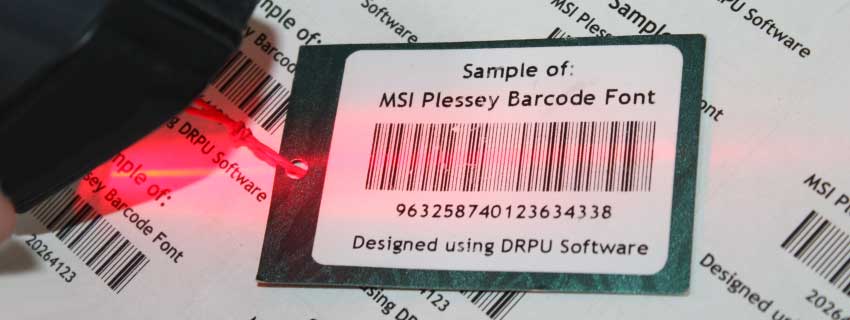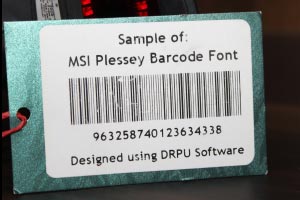Advantages of using MSI Plessey Barcode
MSI Plessey is a continuous, variable-length barcode symbology that is used in various industries for inventory and tracking purposes. It offers several advantages over other barcode symbologies, which make it a popular choice for applications where the amount of data being encoded may vary. In this article, we will discuss the advantages of using MSI Plessey barcode.
-
Variable-Length Encoding
One of the major advantages of MSI Plessey barcode is that it is a continuous, variable-length symbology. This means that it can encode a variable number of characters, making it ideal for applications where the amount of data being encoded may vary. Unlike fixed-length barcode symbologies, MSI Plessey barcode does not require additional space to be allocated for unused characters. This reduces the amount of space required for the barcode and allows it to be more compact.
-
Self-Checking Symbology
MSI Plessey is a self-checking symbology, which means that it contains a built-in error-detection mechanism. This ensures that the data has been encoded correctly and reduces the risk of errors in the data. This makes MSI Plessey barcode a reliable choice for applications where data accuracy is critical.
-
High Density Encoding
MSI Plessey barcode can encode a high density of data, which makes it suitable for applications where space is limited. It can encode up to 13 characters per inch (CPI) when printed with a 300 dpi printer. This means that it can encode more data in a smaller space compared to other barcode symbologies.
-
Easy to Print
MSI Plessey barcode can be easily printed using standard printers. It does not require any specialized printing equipment, which makes it a cost-effective option for applications that can print large number of barcodes. MSI Plessey barcode can be printed on a variety of materials like paper, plastic, etc.
-

-
Wide Range of Applications
MSI Plessey barcode is used in a wide range of applications, including inventory management, tracking, and POS systems. It is commonly used in the retail, healthcare, and manufacturing industries. Its variable-length and high-density encoding capabilities make it suitable for applications where the amount of data being encoded may vary.
-
Low Cost
MSI Plessey barcode is cost-effective for applications where a large number of barcodes need to be printed. It can be easily printed using standard printers and does not require any specialized printing equipment. Its variable-length and high-density encoding capabilities also make it a cost-effective option for applications where space is limited.
-
Easy to Read
MSI Plessey barcode can be easily read using a barcode scanner. The scanner measures the widths of the bars and spaces in the barcode to determine the encoded data. The start and stop characters in the barcode indicate the beginning and end of the barcode. Once the start and stop characters are identified, the decoder reads the values of the bars and spaces in the barcode to determine the encoded data. This makes MSI Plessey barcode an easy-to-read and reliable option for applications where barcode scanning is required.
Download and Install Barcode Software
Limitations of using MSI Plessey Barcode
While MSI Plessey barcode offers many advantages, it also has some limitations. In this article, we will discuss the limitations of using MSI Plessey barcode.
-
Limited Character Set
MSI Plessey barcode can only encode numeric characters. It cannot encode letters or other special characters. This makes it unsuitable for some applications where alphanumeric data needs to be encoded. For example, if a barcode needs to encode both letters and numbers, MSI Plessey would not be a suitable choice in that case.
-
Limited Data Capacity
Although MSI Plessey barcode can encode a variable number of characters, its data capacity is still limited compared to other barcodes. The maximum number of characters that can be encoded in MSI Plessey barcode is 24. This makes it unsuitable for applications where a large amount of data needs to be encoded in a single barcode.
-
Requires a Wide Quiet Zone
MSI Plessey barcode requires a wide quiet zone on either side of the barcode. The quiet zone is an area of blank space that surrounds the barcode to ensure that it can be read accurately by a barcode scanner. The quiet zone is 10 times the width of the narrowest bar in the MSI Plessey barcode. This means that MSI Plessey barcode requires more space than other barcode symbologies.
-
Susceptible to Printing Errors
MSI Plessey barcode is susceptible to printing errors, which can cause decoding errors. The bars and spaces in the barcode need to be printed with a high degree of accuracy in order to ensure that the barcode can be read accurately by a barcode scanner. If the bars and spaces are not printed with the correct width or alignment, the barcode scanner may not be able to read the barcode accurately.
-
Limited Industry Adoption
While MSI Plessey barcode is used in various industries, its adoption is not as widespread as other barcode symbologies such as Code 128 or QR code. This means that not all barcode scanners may be able to read MSI Plessey barcode. If a business is using MSI Plessey barcode, it may need to ensure that its suppliers and customers have the necessary equipment to read the barcode.
-
Limited Error Correction
While MSI Plessey barcode is a self-checking symbology, it does not have error correction capabilities. This means that if a barcode has a missing bar or space, the barcode scanner may not be able to read the barcode accurately. Other barcodes such as QR code have error correction capabilities, which can help ensure that the barcode can still be read accurately even if it is damaged.

MSI Plessey barcode has several limitations that businesses should consider when deciding whether to use this barcode symbology. Its limited character set, data capacity, and wide quiet zone requirements may make it unsuitable for some applications.
Businesses that use MSI Plessey barcode may also need to ensure that their suppliers and customers have the necessary equipment to read the barcode. While MSI Plessey barcode offers advantages such as ease of printing and reading and low cost, businesses should carefully consider its limitations before choosing this barcode symbology for their applications.
Reading and Decoding of MSI Plessey Barcode
MSI Plessey is a continuous, variable-length symbology that is commonly used for inventory and tracking purposes in various industries. In this article, we will discuss how an MSI Plessey barcode is read and decoded.